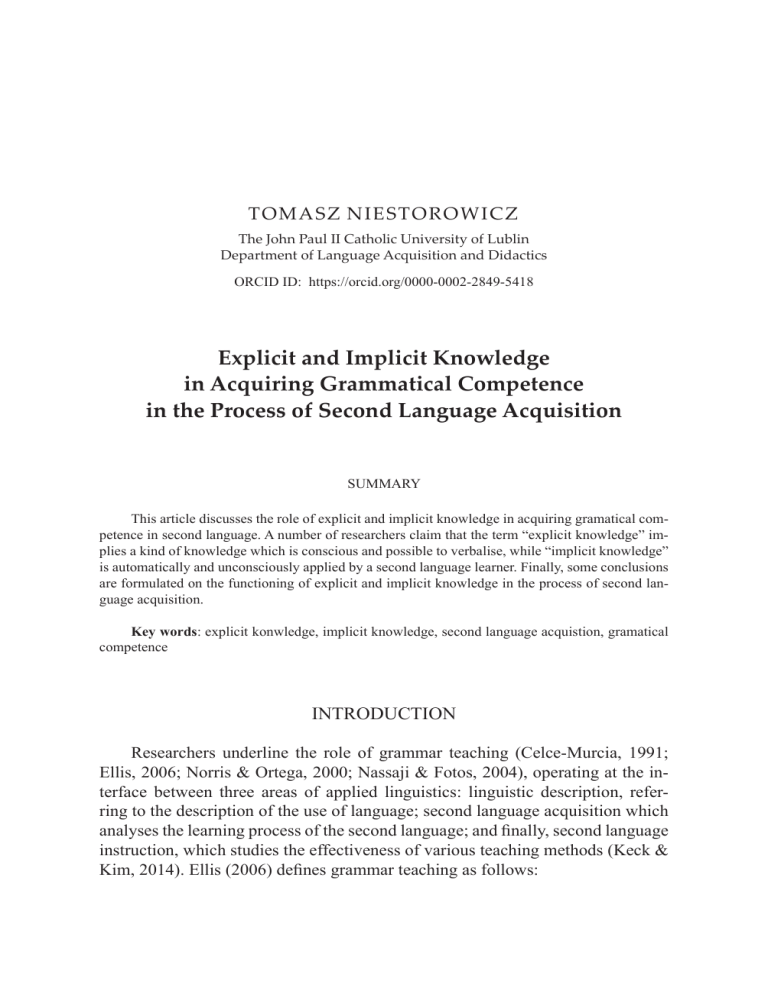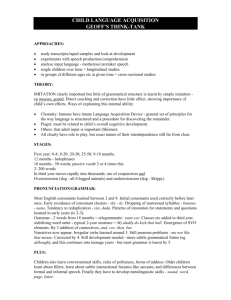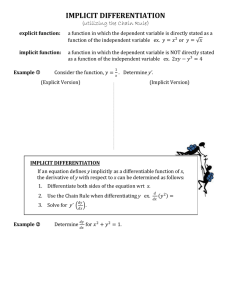
tOMASZ NIESTOROWICZ The John Paul II Catholic University of Lublin Department of Language Acquisition and Didactics ORCID ID: https://orcid.org/0000-0002-2849-5418 Explicit and Implicit Knowledge in Acquiring Grammatical Competence in the Process of Second Language Acquisition SUMMARY This article discusses the role of explicit and implicit knowledge in acquiring gramatical competence in second language. A number of researchers claim that the term “explicit knowledge” implies a kind of knowledge which is conscious and possible to verbalise, while “implicit knowledge” is automatically and unconsciously applied by a second language learner. Finally, some conclusions are formulated on the functioning of explicit and implicit knowledge in the process of second language acquisition. Key words: explicit konwledge, implicit knowledge, second language acquistion, gramatical competence INTRODUCTION Researchers underline the role of grammar teaching (Celce-Murcia, 1991; Ellis, 2006; Norris & Ortega, 2000; Nassaji & Fotos, 2004), operating at the interface between three areas of applied linguistics: linguistic description, referring to the description of the use of language; second language acquisition which analyses the learning process of the second language; and finally, second language instruction, which studies the effectiveness of various teaching methods (Keck & Kim, 2014). Ellis (2006) defines grammar teaching as follows: 140 tOMASZ NIESTOROWICZ Grammar teaching involves any instructional technique that draws learners’ attention to some specific grammatical form in such a way that it helps them either to understand it metalinguistically and/or process it in comprehension and/or production so that they can internalize it. (Ellis 2006: 84) The role and place of grammar in the process of foreign language teaching have been the subject of debates since the beginning of research aimed at establishing the most effective methods in foreign language acquisition. One can agree with Sánchez’s (1992: 1–2) opinion that this discussion is based on the tension between the tendency, on the one hand, to overemphasise the role of grammar and, on the other hand, to minimise its importance in the foreign language teaching. The approach to the role of grammar in foreign language teaching has varied over the years, depending on the method dominating in didactics of foreign language teaching. In the theories based on the grammatical-translation method, normative grammar prevailed with explicit reference to metalinguistic terminology, and the deductive approach was emphasised (explanation of grammatical rules explicitly, and then a reference to specific examples of language use). In the era of domination of the audiolingual method, the point of reference was descriptive grammar and implicit grammar learning, mainly through an inductive technique (the starting point, in this case, is a set of examples of specific grammatical structures that are analysed in order to find certain rules or regularities in their functioning) (Sánchez, 1997). In the 1980s, Stephen Krashen proposed a set of hypotheses regarding the nature of second language learning (Krashen, 1982), which for decades constituted the starting point for a discussion on the place of grammar in foreign language teaching. The first hypothesis is a classic distinction between language acquisition and language learning. Language acquisition takes place intuitively and unconsciously, whereas the learning process is based, according to the author, on the conscious reflection on the language, contributing to the development of metalinguistic knowledge (Kurcz, 2009). Krashen, denying the existence of the “critical period”, assumes that the ability to acquire a language does not disappear when adolescence ends. Adults can, therefore, in the author’s opinion, like children, fully benefit from the innate mechanism of language acquisition (Noam Chomsky’s LAD), which is supposed to be more effective than formal learning. The above theory is related to the “natural sequence” hypothesis, which refers to as much interesting as the controversial comparison of the process of children’s first language acquisition with adults’ second language acquisition. Krashen constructs this concept, based on research carried out by Brown (1973) and Dulay & Burt (1974). The results of the study indicate a similar learning sequence of specific grammatical structures by children and adults e.g., in English, the acquisition of the past time morpheme -ed is usually preceded by the learning of the use Explicit and Implicit Knowledge in Acquiring Grammatical... 141 of morpheme -ing. According to the researchers, correcting errors by a parent or a teacher does not affect the order of acquisition of specific grammatical structures (Keck & Kim, 2014). One of the most discussed Krashen’s theories is the „monitor” hypothesis (Krashen, 1981), in which the conscious metalinguistic reflection on grammatical rules has a negative influence upon the fluency of oral expression. However, it can be used to analyze, for example, the correctness of the written expression. Therefore, the positive role of a „monitor” can be accepted in the case of language skills, in which due to their specificity, the time interval allowed for linguistic reflection, can be relatively large (writing and reading), (Hinkel & Fotos, 2002) and one can observe the lack of efficiency of the „monitor” in the case of productive skills, due to the too short time interval necessary for reaching the explicit knowledge (speaking and listening) (Elder & Ellis, 2009). In the further part of the article, based on the literature of the subject, I intend to refer to issues related to the above theory. This article focuses mainly on the concept of learning grammar explicitly or through the process of implicit acquisition of grammatical competence. EXPLICIT AND IMPLICIT KNOWLEDGE IN THE PROCESS OF SECOND LANGUAGE ACQUISITION / LEARNING In the process of foreign language teaching, the term “explicit knowledge” refers to the type of knowledge concerning various aspects of language, including grammar, which a learner acquires consciously, he/she can verbalise it, as well as recall it when encountering language difficulties in using a second language. In this respect, what is being considered is metalinguistic knowledge/awareness, to which, for example, a non-native English or Spanish language speaker can gain access through a controlled process, at the time of recalling the grammatical rule regarding the use of plurals or the rules of using past tenses. In contrast, the “implicit knowledge” can be defined as an instrument used unknowingly by a person learning a second language. Access to this type of knowledge can be achieved automatically in the course of fluent language communication, through the direct application of a given grammatical rule (Ellis, 2006; Paradis, 2009). One of the topics that have been lively discussed for decades, is the question whether the explicit teaching of grammar is necessary for developing language competence. In the first years of the process of the child’s first language acquisition, his/her natural exposure to the language and interaction with native speakers seem to be sufficient to acquire grammatical competence. Before starting formal learning in the institutional setting, children acquire grammar mainly implicitly. The situation is different in the case of an adult foreign language learner: 142 tOMASZ NIESTOROWICZ explicit grammar teaching aims at developing metalinguistic awareness, raising awareness of grammatical structures and drawing attention to the most particular aspects of a given language (Paradis, 2009). Many researchers also address the issue of dependency/interaction between explicit and implicit knowledge. Ellis (2006) focuses on the three different positions regarding the interaction between these two phenomena. On the one hand, as part of the “noninterface position” (Krashen, 1981, 1985), it is assumed that explicit and implicit knowledge are two separate systems, so one type of knowledge cannot be transformed into another. This may result primarily from the neurological distinctness of declarative (explicit) memory and procedural (implicit) memory, suggested by some neuroscientists (Paradis, 1994, 2009). The opposite position (interface position) is presented by , among others, De Keyser (1998, 2003), who sees a natural transition from explicit to implicit knowledge in the learning process. The more nuanced version of this opinion assumes that explicit knowledge can be transformed into implicit knowledge under certain conditions: a learner must be prepared to acquire a given grammatical structure; therefore he/ she should be at an appropriate level of competence in a target language (Ellis, 1993) and to be able to “notice” a particular form, that is, to recognise it consciously (Schmidt, 1990). Most scholars agree that the development of implicit knowledge is an essential goal to be pursued, and plays a central role in the process of learning/teaching (Krashen, 1982, Paradis, 1994, Doughty, 2003). However, the role of knowledge, which can facilitate or accelerate the development of language competence through interaction with implicit knowledge (Hulstin, 2002; Ellis, 2006; Paradis, 2009; DeKeyser, 2015), should not be diminished. It can also be an extremely useful tool in solving language difficulties in the absence of learned automatisms. It is then a resource that can be referred to by recalling grammatical rules, constructed on the basis of hypotheses, correct or not, by a foreign language learner; it also serves to highlight specific features of grammatical structures (N. Ellis, 2005). As Paradis (1994) points out, the issues concerning the acquisition and use of morphosyntax and phonology are related to procedural memory, while lexical units are compatible with declarative memory. Therefore, the lexicon is less susceptible to a period of reduced sensitivity for language in adulthood. The utterances produced by those foreign language learners, who during the conversation mainly use explicit knowledge and did not have previously the opportunity to practice specific grammatical structures in the natural environment, are usually characterised by a slow pace, numerous pauses, and numerous autocorrections. In short , they are related to the use of metalinguistic operations to convey a correct and acceptable message. If the linguistic reflection accompanying utterances is made off-line in a conscious and controlled manner, for example to correct an ex-post utterance or to construct a sentence accurately and correctly, the reverse Explicit and Implicit Knowledge in Acquiring Grammatical... 143 of this situation is an on-line utterance, made automatically and without involving consciousness (Paradis, 1994). The research by Yuan and Ellis (2003) showed that planning and monitoring oral expression has a positive impact on linguistic correctness and the richness of grammatical structures used by learners, which could be associated with sufficient time for linguistic reflection and access to explicit knowledge. From the perspective of the average native speaker of a language, recognizing an utterance as ungrammatical/unacceptable by that user, does not necessarily mean having an explicit/meta-linguistic knowledge in relation to a given utterance. It can often be an unconscious/implicit belief that „this sentence does not sound right”, „ you do not say it this way”, for example in case of a sentence in Spanish * Me gusta las fotos an average Spanish language speaker would recognise the above sentence as incorrect, but he/she may have problems with the metalinguistic explanation of the rule, namely that the lack of correctness results from the lack of agreement between the predicate and the noun las fotos, which acts as the subject and not the complement (the postposition of the subject may be misleading in this case). The assumption of a lack of interaction between declarative knowledge and procedural knowledge is questioned, among others by Lee (2004) and Crowell (2004). The authors indicate that from the perspective of the neuroanatomy of the brain, the areas responsible in the cerebral cortex for declarative and procedural memory are common. According to Lee (2004), the area of the hippocampus, responsible for declarative memory and related to learning, may interact with areas in the basal ganglia, responsible for the procedural memory that is associated with the acquisition process. As Crowell (2004) suggests, the automation of declarative knowledge through language practice may be associated with strengthening connections in the basal ganglia, while weakening them in the hippocampus area. BASIC PROBLEMS IN STUDIES ON EXPLICIT AND IMPLICIT ACQUISITION OF GRAMMATICAL COMPETENCE According to Suzuki and DeKeyser (2017), it is necessary to distinguish between (partially) automated explicit knowledge and implicit knowledge. The authors carried out pioneering studies confirming the empirical effect of learning foreign language grammar explicitly on automating the explicit knowledge, which interacts simultaneously with implicit knowledge (while the influence of implicit learning on the acquisition of implicit knowledge was not observed). Explicit language learning is the process of knowingly acquiring grammatical rules, while language learning implicitly refers to the learning of certain language regularities without conscious intention (Suzuki & DeKeyser, 2017). In order to distinguish 144 tOMASZ NIESTOROWICZ between automated explicit knowledge and implicit knowledge, the criterion of conscious access to linguistic knowledge was adopted. Both of these types of knowledge assume quick and automatic access to grammatical information, but only in case of automated explicit knowledge the access is conscious (Suzuki & DeKeyser, 2017). The study involved 100 native speakers of Chinese language, learning Japanese as a second language in formal education. The tests carried out by the researchers were based on tasks investigating the response time in the case of implicit knowledge and time-limited tests in which the grammaticality of a given linguistic utterance should be assessed in the context of automated explicit knowledge. The content of the tests was the use of grammatical structures, including transitive and intransitive verbs. The tests referring to implicit knowledge were to examine the understanding of the meaning of utterances (by eye-tracking technique or by choosing the correct answer on the computer screen, the text was read or listened), while tests studying automated explicit knowledge focused on the grammatical form - the subject was asked to search for grammatical errors in a sentence or filling in gaps with a target grammatical structure (the text was read or listened to). While describing the results of the research, the authors suggest that formal, explicit language learning influences the acquisition of automated explicit knowledge, which in turn positively influences the process of acquiring knowledge implicitly. Thus, it is possible to notice an increase in the efficiency of language information processing and language production in a grammatically correct manner through the process of automating the grammar rules previously acquired by learners of a foreign language. The conclusions of Suzuki’s and DeKeyser’s studies are therefore consistent with those of most researchers (Hulstijn, 2002, N. Ellis, 2005, R. Ellis, 2006; Paradis, 2009), which highlight the positive influence of the explicit grammar learning on the acquisition of implicit knowledge. However, the authors emphasise that this influence is indirect and only occurs by automating the formal knowledge of grammar rules. It is difficult to generalise in the case of Suzuki’s and DeKeyser’s studies, given the fact that there is a significant variation among people in the research group: the period of Japanese formal learning ranged from 3 months to 7 years, while language immersion time varied from 2 to 16 years. Therefore, the fundamental question seems to be whether the lack of formalised, explicit learning of grammar affects the linguistic development of a second language learner? Swain and Lapkin (1989) are the authors of a series of research on the development of language skills of English-speaking students of Canadian schools participating in the French language learning program through immersion in the second language. After a few years of learning French by the Canadian students, the researchers observed progress in the students’ utterances in French regarding the level of fluency, while the learners did not acquire sufficiently many grammatical structures. The correctness of their utterances was Explicit and Implicit Knowledge in Acquiring Grammatical... 145 therefore far from that presented by French native speakers. Therefore, it may be problematic to concentrate the teaching process on the transfer of linguistic information, which is not accompanied by explicit grammar teaching. Schmidt (1983) described the results of a case study of a Japanese learning English in the United States outside of formal education, only through natural exposure to the language. The study pointed to the following conclusions: during the three-year period of exposure to a foreign language, the grammatical competence of the examined person developed slightly, during the whole period there was no progress in knowing certain forms (e.g., -ing form or past-time morpheme -ed). DeKeyser’s research (2010) describes a six-week stay of English-speaking students as part of the Spanish language programme at one of the Argentinian universities. The author emphasises that the students attributed great importance to the conscious application of grammatical rules in the course of conversations with Spanish native speakers. The bigger formal knowledge of grammatical rules students had before coming to Argentina, the higher they assessed the impact of their stay in a Spanish-speaking country on the development of their language competence. In other words, in this case, mastering the system of grammar rules seems necessary for the process of learning a foreign language more profoundly. CONCLUSION Metalinguistic reflection and the gradual development of explicit knowledge is an essential factor in second language learning. For a foreign language learner, the point of reference is the mother tongue, on which the metalinguistic awareness is originally constructed (in the later stages of education it may be another foreign language). By referring to the mother tongue, it is possible to reflect on similarities and differences between the first language and the second language (Cesteros, 2005, Kurcz, 2009), which influences the development of metalinguistic knowledge, as well as the acquisition of metapragmatic knowledge, which is necessary for the development of communication skills. It should also be taken into account that grammar teaching is related, among others, to the age criterion of a learner. Children learn grammar primarily implicitly, without conscious metalinguistic reflection. Teaching young people and adults usually requires an explicit explanation of grammar rules, even more so due to the fact that metalinguistic awareness grows with the acquisition of subsequent levels of education (Paradis, 1994). Explicit grammar learning can speed up foreign language learning through constructing a basis for the future conscious use of grammatical structures in a second language. It can also be assumed that automating explicit knowledge is possible by practicing and repeating specific grammatical structures, especially in the initial stages of foreign language 146 tOMASZ NIESTOROWICZ learning; metalinguistic reflection and profound reflection on the functioning of grammatical rules are necessary at the advanced level. One should take a critical look at the postulated for several decades decrease of the importance of grammar in didactics of foreign language teaching. Implicit grammar teaching, only through exposure to a foreign language, may not be sufficient to develop the grammatical competence of a foreign language learner fully. The issue of the presentation of the grammatical material, which cannot be limited only to explaining explicit grammatical rules, especially with the use of examples that do not contain a broader communication context, is a matter for discussion. An interesting point of reference may be an approach which in foreign language teaching is defined as the focus on form (Long, 1991). This approach is characterised by metalinguistic consciousness-raising in the case of a foreign language learner, through the analysis of grammatical structures in a specific and extensive communication context. This allows us to notice the links between the grammatical form, its meaning and appropriate use in a specific linguistic context (Keck &Kim, 2014). Bibliography Brown R., 1973, A first language: the early stages, Harvard University Press, Cambridge MA. Celce-Murcia M., 1991, Grammar pedagogy in second and foreign language teaching, “TESOL Quarterly”, 25 (3), 459–480. Crowell S., 2004, The neurobiology of declarative memory, [w:] The neurobiology of learning: perspectives from second language acquisition, red. J. Schumann, S. Crowell, N. Jones, N. Lee, S. Schuchert, Mahwah, 75–109. DeKeyser R., 1998, Beyond focus on form. Cognitive perspective on learning and practicing second language grammar, [w:] Focus on form in classroom second language acquisition, red. C. Doughty, J.Williams, Cambridge, 42–63. DeKeyser R., 2003, Implicit and explicit learning, [w:] The handbook of second language acquisition, red. C. Doughty, M.H. Long, Oxford, 313–348. DeKeyser R., 2010, Monitoring processes in Spanish as a second language during a study abroad program, “Foreign Language Annals”, 43, 80–92. DeKeyser R., 2015, Skill acquisition theory, [w:] Theories in second language acquisition: an introduction, red. B. VanPatten, J. Williams, New York, 94–112. Doughty C., 2003, Instructed SLA: constraints, compensation, and enhancement, [w:] The handbook of second language acquisition, red. C. Doughty, M.H. Long, Oxford, 256–310. Dulay H., Burt M., 1974, Natural sequences in child second language acquistion, “Language Learning”, 24, 37–53. Elder C., Ellis, R., 2009, Implicit and explicit knowledge of an L2 and language proficiency, [w:] Implicit and explicit knowledge in second language learning, testing and teaching, red. R. Ellis, S. Loewen, C. Elder, R. Erlam, J. Philp, H. Reinders, Bristol, 167–193. Ellis N., 2005, At the interface: dynamic interactions of explicit and implicit knowledge, “Studies in Second Language Acquisition”, 27, 305–352. Explicit and Implicit Knowledge in Acquiring Grammatical... 147 Ellis R., 1993, Second language acquisition and the structural syllabus, “TESOL Quarterly”, 27, 91–113. Ellis R., 2006, Current issues in the teaching of grammar: an SLA perspective, “TESOL Quarterly”, 40, 83–107. Hinkel E., Fotos S., 2002, From theory to practice: a teacher’s view, [w:] New perspectives on grammar teaching in second language classrooms, red. E. Hinkel, S. Fotos, Mahwah, 1–12. Hulstijn J., 2002, Toward a unified account of the representation, processing and acquisition of second language knowledge, “Second Language Research”, 18, 193–223. Keck C., Kim Y., 2014, Pedagogical grammar, John Benjamins Publishing Company, Amsterdam – Philadelphia. Krashen S., 1981, Second language acquisition and second language learning, Pergamon, Oxford. Krashen S., 1982, Principles and practice in second language acquisition, Pergamon, Oxford. Krashen S., 1985, The input hypothesis: issues and implications, Longman, New York. Kurcz I., 2009, Dwujęzyczność a język globalny, [w:] Problemy współczesnej dydaktyki języków obcych, red. M. Pawlak, M. Derenowski, B. Wolski, Poznań – Kalisz, 11–27. Lee N., 2004, The neurobiology of procedural memory, [w:] The neurobiology of learning: perspectives from second language acquisition, red. J. Schumann, S. Crowell, N. Jones, N. Lee, S. Schuchert, Mahwah, 43–73. Long M., 1991, Focus on form: a design feature in language teaching methodology, [w:] Foreign language research in cross-cultural perspective, red. K. de Bot, R. Ginsberg, C. Kramsch, Amsterdam, 39–52. Nassaji H., Fotos S., 2004, Current developments in research on the teaching of grammar, “Annual Review of Applied Linguistics”, 24, 126–145. Norris J.M., Ortega L., 2000, Effectiveness of L2 instruction: a research synthesis and quantitive meta-analysis, “Language Learning”, 50, 417–528. Paradis M., 1994, Neurolinguistic aspects of implicit and explicit memory: implications for bilingualism and SLA, [w:] Implicit and explicit learning of languages, red. N. Ellis, San Diego, 393–419. Paradis M., 2009, Declarative and procedural determinants of second languages, John Benjamins Publishing Company, Amsterdam. Pastor Cesteros S., 2004, El papel de la reflexión metalingüística en la adquisición de la gramática de E/LE, [w:] Las gramáticas y los diccionarios en la enseñanza del español como segunda lengua, deseo y realidad: Actas del XV Congreso Internacional de ASELE, red. M. Castillo Carballo, Sevilla, 638–645. Sánchez A., 1992, Historia de la enseñanza del español como lengua extranjera, SGEL, Madrid. Sánchez A., 1997, Los métodos en la enseñanza de idiomas. Evolución histórica y análisis didáctico, SGEL, Madrid. Schmidt R., 1983, Interaction, acculturation, and the acquisition of communicative competence, [w:] Sociolinguistics and language acquisition, red. N. Wolfson, E. Judd, Rowley, 137–174. Schmidt R., 1990, The role of consciousness in second language learning, “Applied Linguistics”, 11, 129–158. Suzuki Y., DeKeyser R., 2017, The interface of explicit and implicit knowledge in a second language: insights from individual differences in cognitive aptitudes, “Language Learning”, 67, 747–790. Swain M., Lapkin S., 1989, Canadian immersion and adult second language teaching: what’s the connection?, “The Modern Language Journal”, 73, 150–159. Yuan F., Ellis R., 2003, The effects of pre-task planning and on-line planning on fluency, complexity, and accuracy in L2 oral production, “Applied Linguistics”, 24, 1–27.







